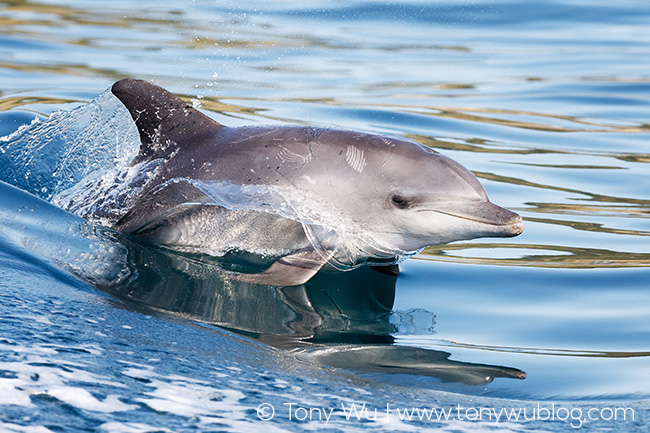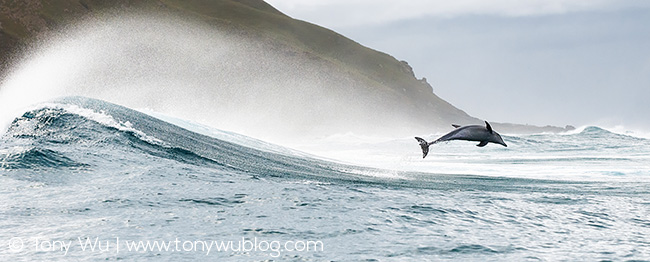I recently visited South Africa. It was a short stay, focused (terrible pun intended) on watching dolphins, like these Indo-Pacific common dolphins:

If there's one thing this type of dolphin does well, it's fly. Not literally of course, but rather, in the sense of moving rapidly. Like really, really super-hyper-crazy-ridiculously-mind-blowing fast. Me trying to photograph them was like Wile E. Coyote trying to pin down the Roadrunner fueled by a six-pack of Red Bulls.
We were fortunate to come across a couple of groups while they were ripping into schools of bait fish. Fortunate for us, not so much for the fish of course.
It's the first time I've spent any time around commons, so in between deleting botched photos, I was engrossed in watching their behaviour. One thing I think I picked up on is one of their strategies for catching meals.
A group of them line up, herd a group of fish, then chase their prey in unison at high speed. This sends the hapless soon-to-be-pre-packaged-nutritious-yet-still-tasty-dolphin-snacks fleeing in panic. In many cases, one or more dolphins leaps into the air and re-enters the water, sometimes immediately, sometimes after a body length or two.
At first, all the jumps looked the same. Then I noticed that, in hunting situations, the dolphins often turned to their sides, with one eye looking down into the water. Hmmm.

Then I noticed that dolphins behaving this way frequently made sudden stops mid-air, completely flipping their bodies upright in some instances, to jackknife into the water. The body language was markedly different from how the dolphins moved in non-hunting scenarios.
I'm guessing that the dolphins leap into the air and turn on their side in order to get a bird's-eye view, so to speak. They then choose their moment and point of re-entry into the water based on their aerial vantage point, thus totally ruining their target fish's day. Ingenius.

I can't be 100% sure that this is what's taking place, but as soon as I picked up on what I believed to be one of their primary strategies, it became easier to follow the action and capture photos.
There were also lots of Indo-Pacific bottlenose dolphins (Tursiops aduncus), perhaps more than I've seen gathered in any other single location. We easily came across hundreds every day. I'd be willing to say thousands on many days.

Bottlenose dolphins are generally more chilled-out than their common counterparts. We encountered them in groups of only a few individuals to pods comprising several dozen. For the most part, they were relaxed, probably resting, or socialising a teeny bit at most.
The exception was when they decided to surf.
It didn't happen often, and as luck would have it, whenever some decided to frolic in the waves, conditions were overcast, or we were too far away to photograph effectively.
There were a few times when we were in the right place at the right time, like this:

and this:

Each time the bottlenose dolphins launched themselves from the surf, we could feel the joy, the sheer pleasure, that these acrobats of the sea were experiencing. Who says animals don't know how to have fun?
One dolphin's fun is often one photographer's frustration though.
Knowing that dolphins are going to surf is one thing; predicting exactly where and when they're going to fly out for a split-second and capturing the decisive moment while you're on a moving boat is another thing entirely.
As my friend Steve put it: "It's like trying to photograph popcorn pop." Yup, exactly, but I would add: "From 50m away, in random directions, standing on a boat moving in unpredictable fashion." Perfect.
I reconciled my frustration by blaming the cloudy weather and unpredictable animals on Steve. Bad Steve. Bad, bad Steve.
One final dolphin picture. This is bottlenose dolphin slicing through the water on a calm, sunny day. I love how the dolphin's dorsal splits the water in two and throws up a beautiful butterfly wake.
